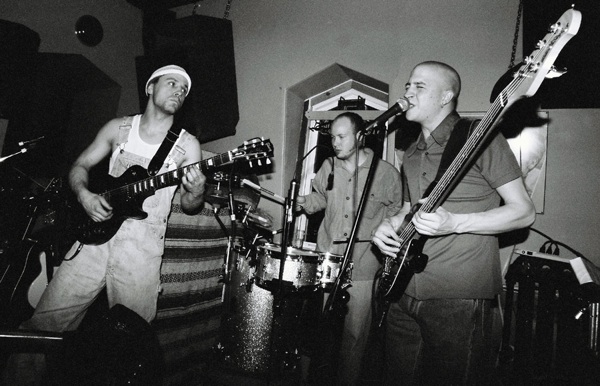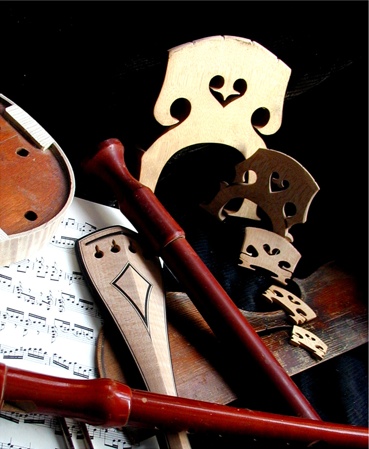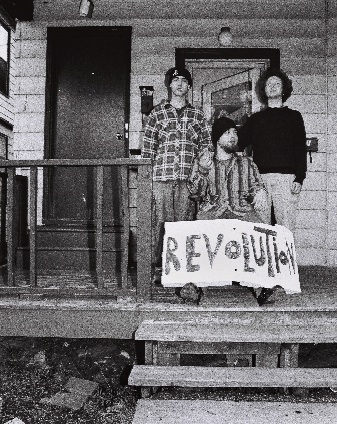
Seeing the Music: East Coast Photographers/ East Coast Musicians opened at CBU Art Gallery about a month ago in conjunction with the East Coast Music Awards, but its run comes to an end this week, on Friday. If you have had any involvement with or interest in the East Coast music scene over the past twenty years or so, it is well worth taking a stop by CBU to check out this exhibit before it closes. The show features the works of five artists, at varying stages of their careers, who have documented the rich tradition of East Coast music through photography: Kelly Clark, Carol Kennedy, Otis Tomas, Murdock Smith, and Nathan Boone.
Walking through Seeing the Music: East Coast Photographers/ East Coast Musicians, was like walking through time for me. The photographs by Murdock Smith, Carol Kennedy and Nathan Boone, especially, brought me back through the last fifteen years of my life in and around the East Coast music industry. From Kennedy’s iconic black and white publicity photos of East Coast artists from the nineties, to Smith’s shots of the musical landscape we both lived in working on WGO and living in the House of Rock, to Boone’s images from the last couple of years—which include me playing with the Tom Fun Orchestra—this scenery was all so familiar to me. Presented next to the Halifax-centric subjects of Kelly Clark—who has won five Photographer of the Year ECMAs, and Otis Tomas’ still life portraits of his instruments, familiar became a very relative term.
While I had a very intimate connection to the photos of Kennedy, Smith, and Boone, having experienced aspects of my life with these images, Clark and Tomas’ photos were also familiar, but not in as immediately identifiable a way.
I recognized some of the people in Kelly Clark’s photos, either because I know them, (Mairi Rankin, Gillian Boucher, Mary Jane Lamond, Natalie MacMaster), or because I know of them (Sarah McLachlan, Buck ’65, Classified). Clark, who graduated from Nova Scotia College of Art & Design with a BFA in 1995, has spent much of her career chronicling the development of East Coast music in Halifax, with a focus on the underground hip hop scene. I am somewhat removed from what has been going on in Halifax, whether in hip hop or classical music, over the past fifteen years, but Clark’s photos in this exhibit brought it all to life immediately and I was quickly able to make the connection between the pictures—Classified in the studio, Jordan Croucher’s album cover, classical pianist Lorraine Min, or conductor Georg Tintner—and what I knew of music in Halifax.
The subjects of Otis Tomas’ photos were also familiar to me, but at the same time, slightly more obscure. Tomas is a primarily a luthier who has built over 400 instruments at his shop in the North River area of Cape Breton. The subject of his photos are his instruments, and he’ll be the first to tell you that he doesn’t really consider himself a photographer.
“I really don’t consider myself a photographer,” says Tomas when asked about the exhibit. “I have no real background or training, and I never set out to be, or claimed that I was, any kind of artist in that sense. My photography in this vein started as a way to document and present my work as a luthier, and that’s what most of my photographic work is. From my other activities as an instrument maker and musician, I guess I had a certain sense of composition and an eye for detail that I try to bring to my photos so that they would be representative of the sensibility with which I engage my work. So in that sense, my photography was always secondary to my ‘real’ work. But naturally, I also occasionally like to step outside those boundaries and just take a picture for the play of it, often as a gift to a friend or for some personal occasion—often arranging or composing a sort of ‘still life’ of which there are a couple of examples in the show at the CBU gallery.”

Tomas’ photos capture the detail of his instruments—in pieces as they are being assembled, as completed works of art, in curious situations, and as character studies. CBU Art Gallery Curator Laura Schneider writes of Tomas’ photos being “frequently tactile and sensuous, [they] sometimes move towards abstraction.” And to me, that is the intrinsic beauty in his photos. They go beyond what you would reasonably expect of a craftsman taking photos of his work. These are not simply “product shots”, they are intimate and artistic portraits.
Tomas says he’s never even considered exhibiting his photos in any kind of a gallery setting, and that it was well-known photographer, and neighbor, Carol Kennedy who suggested it to Schneider. But it’s not like of his work has never been seen.
“I do have a number of pictures on my website and I’ve given a number of them to my friends, but other than that, I haven’t really sought public exposure for them,” says Tomas. “I naturally gravitate toward musical subjects, mainly because that’s always been so much the focus of my life. In a sense, I feel that my photos are of a piece with the other aspects of my work in making instruments, composing, and playing music.”
While this exhibit was an unveiling of sorts for Otis Tomas’ photographs, I would be surprised if anyone with any history in East Coast music hasn’t seen Carol Kennedy’s work. Her black & white portraits of artists including The Rankin Family, Rita MacNeil, The Barra MacNeils, Natalie MacMaster, Rawlins Cross, Laura Smith, J.P. Cormier, John Allan Cameron, Mary Jane Lamond, Jerry Holland, Brenda Stubbert, Howie MacDonald, Jennifer Roland, and Duncan Wells were primarily used as publicity / promotion photos, and as a result appeared everywhere from album covers to promotional posters to the pages of newspapers and magazines. Kennedy’s photos practically defined what music on the East Coast of Canada looked like in the 1990s.
Kennedy’s background in photography goes back 35 years and was centered on art and commercial work until 1989. “I met Stephen MacDonald in 1989,” recounts Kennedy. “He liked my black and white photography approach and style and commissioned me to do the Rankin Family first album. We met at the Cedars Club. That photo started it all.” Kennedy went on to photograph practically every well-known professional artist on the East Coast, winning an ECMA for Photographer of the Year in 1998, and her work has become an important part of the visual history of Atlantic Canada’s music.
Between my work with What’s Goin On magazine (starting in 1995), and as Information Officer for Celtic Colours International Festival (since 1999), I relied heavily on Kennedy’s work. The majority of artist photos used in the Celtic Colours programs during the first couple of years were publicity shots by Carol Kennedy, and if I received a press kit of an East Coast artist at What’s Goin On, or requested a photo from an artist who was operating at the level that the magazine would need a photo, there was a better than average chance that that photo was going to be a Carol Kennedy photo. While these photos served a purpose, and served it well, sometimes what I needed was an action shot or someone to go out and get a photo at an event.

Murdock Smith started taking photos in High School, where he worked on the yearbook, before going on to Holland College and receiving a diploma in photography. He’s been working in the field ever since, getting into photographing musical subjects while hanging out with his friends who would go on to form the band Sunfish. Through these mutual friends, I enlisted his help with What’s Goin On and he became the main photographer for the magazine. Smith’s specialty became the action shot, capturing the musician in the act of making music and in the course of his career, he’s captured many classic moments, both with What’s Goin On and later as official photographer of Celtic Colours International Festival. Included in this exhibit are some of Smith’s “greatest hits” from the local underground—Sunfish, the Squatters with Colleen Power, Carlo Spinazzola, The Wayouts, Vegapeeler, Slowcoaster—and of artists like the Barra MacNeils, Gordie Sampson, Ashley MacIsaac and J.P. Cormier. For me, Smith’s photos are the most powerful in the exhibit because they represent very real times that I lived in, depicting people that I lived with, and they brought me back to those places and those times in a way that is very hard to describe, but in a way that pretty much defines the power of a photograph.
Nathan Boone has taken Smith’s ability to capture the moment one step further, it seems, with the collection of his photos in this exhibit. Most of Boone’s shots are of Tom Fun Orchestra and its various members, past and present, including closeups of Ian MacDougall, Carmen Townsend, Albert Lionais, Victor Tomiczek, Zach MacLean, Donnie Calabrese and myself, as well as a few shots of Carleton Stone Drives the Big Wheel and Matt Minglewood. Each of his images—digital photos, numbered in the exhibit rather than described or identified by subject name—feels like it gets in close, even if it’s not a close-up. Schneider describes it best: “Many of Nathan Boone’s photographs straddle the raucous moments of performance and the intentional realm of portraiture. Although not constructed as such, his photos of individuals caught in mid-performance can operate as raw, unguarded portraits. The images are effective because they embody such energy and sound, but they are in fact silent, fleeting glimpses into a brief spectacle. Boone’s photographs encourage us, however abstractly, to imagine the music in our heads, but provide a safe distance from which to observe without being implicated in the performance.”
Seeing the Music: East Coast Photographers / East Coast Musicians is an entertaining collection of 85 photographs that makes a connection between sight and sound, past and present, and motion and stillness, in ways that you do not expect. “The dual nature of music and photography—both equally concerned with the infinite and the present—make them natural partners,” writes Schneider. “Photographs of live performance have the ability to conjure a particular time, place and sound. The portrait photographer has the ability to enshrine a musical persona in the public’s consciousness. And yet perhaps it is this duality, this infinite present that is at the heart of both of these art forms.”
Experience it for yourself while you still can. Seeing the Music: East Coast Photographers / East Coast Musicians runs until Friday, April 9 at the CBU Art Gallery.

